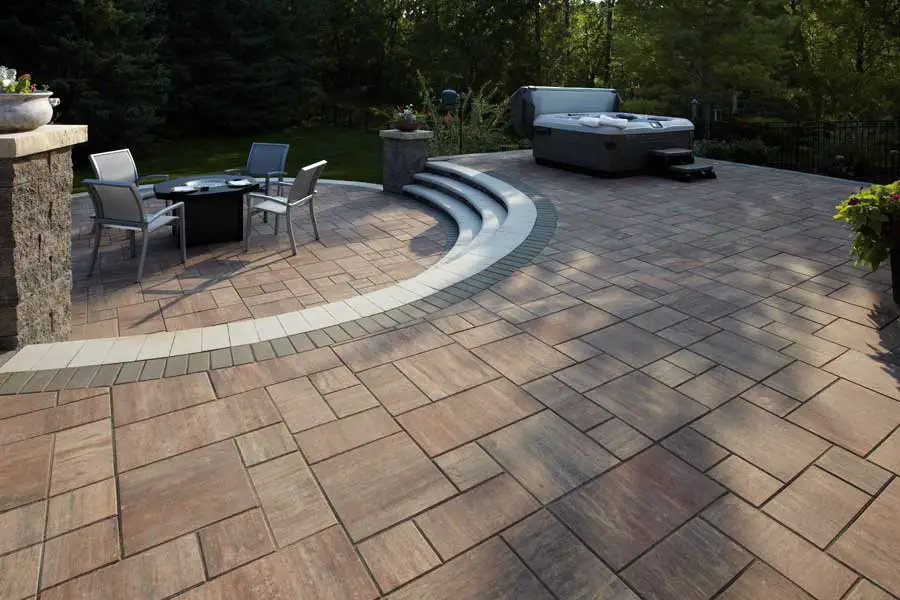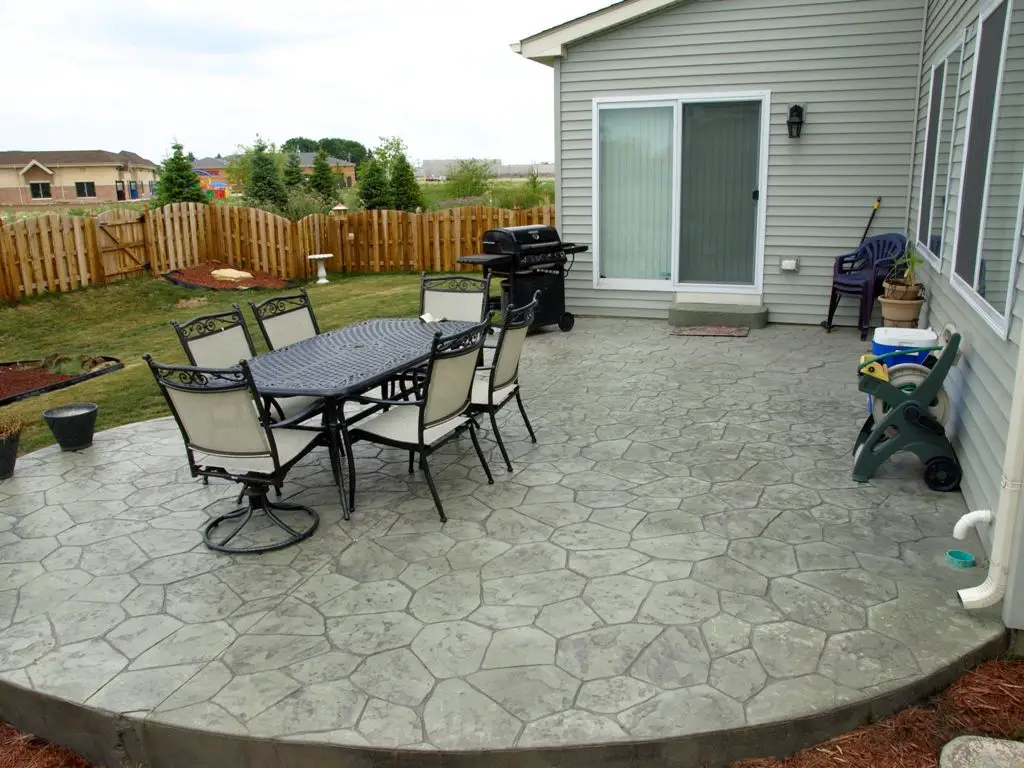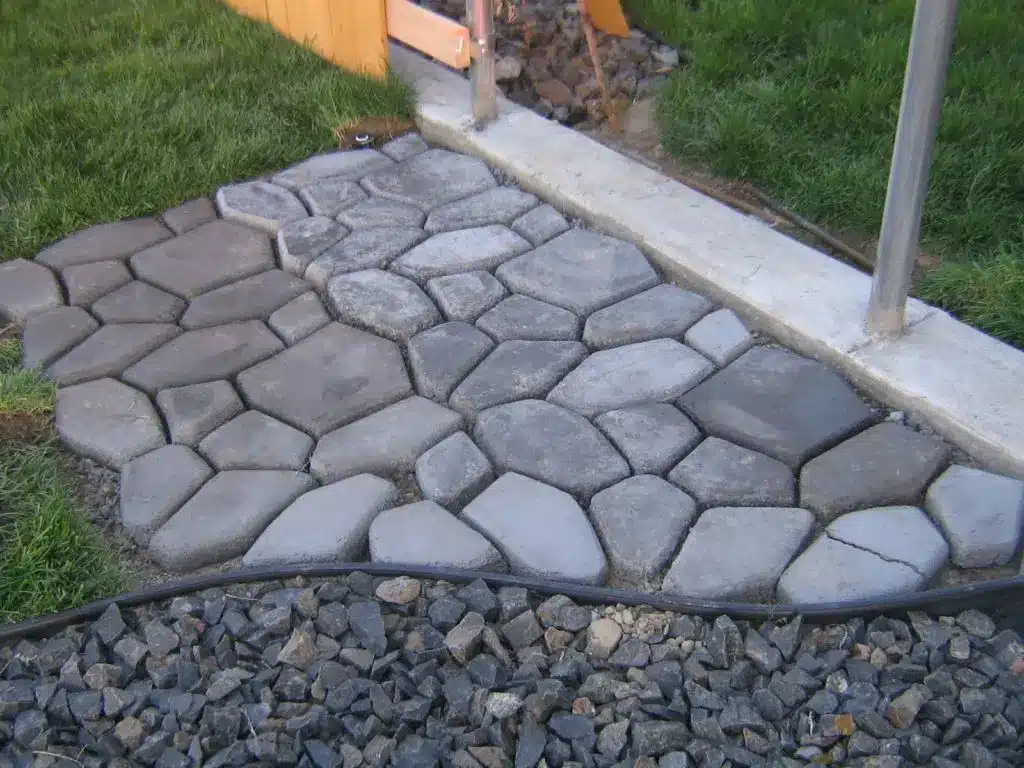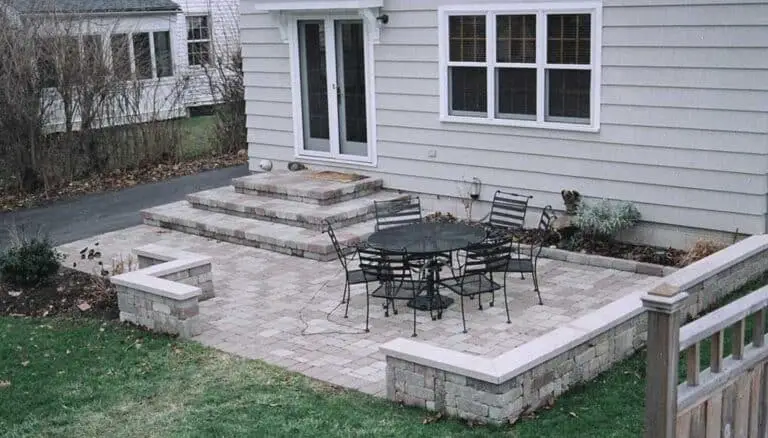Introduction
How To Make A Concrete Patio More Attractive: A concrete patio can be a versatile and durable outdoor space, providing the perfect area for relaxation, entertainment, and family gatherings. However, many homeowners often find themselves facing a common challenge – a plain and uninviting concrete surface that lacks visual appeal. The good news is that transforming a mundane concrete patio into a stunning and attractive oasis is entirely within reach. With a few creative ideas and thoughtful enhancements, you can elevate the aesthetics of your best outdoor space, turning it into a captivating extension of your home.
In this guide, we will explore a variety of techniques and design elements that can breathe new life into your concrete patio. From simple DIY projects to more elaborate upgrades, you’ll discover inspiring ways to create a patio that reflects your style and personality.
Decorating a concrete patio is one of the best ways to improve its appearance. Stamped concrete mimics the look of natural stone, brick, and tile without the cost. Stamped concrete adds character and depth to flat surfaces with its many patterns and textures. Concrete staining is also a great option for patio color issues. Acid- and water-based stains can give concrete a variety of colors and finishes. This update refreshes the patio and adds a personal touch.

How can I make my cracked concrete patio look better?
Applying a concrete sealant is an easy task that anyone can do. All you need is a caulking gun, a putty knife, and a bucket of sealant, which you can buy at any hardware store. Sealing your common concrete cracking can help make your patio look smooth again.
Making a cracked concrete patio look better doesn’t have to be a daunting task. With a few creative solutions and some simple upgrades, you can turn your weathered surface into an attractive and inviting outdoor space.
Repair the Cracks
The first step to improving the appearance of your cracked concrete patio is to address the cracks themselves. Fill in minor cracks with concrete patching compound, and for larger cracks or those with significant damage, consider hiring a professional to perform more extensive repairs.
Concrete Overlay
If the cracks are extensive or unsightly, a concrete overlay can be an excellent solution. This thin layer of fresh concrete can be applied over the existing surface, hiding the cracks and giving your patio a smooth, refreshed look.
Staining or Painting
Concrete stains or paints offer an opportunity to change the color of your patio, concealing imperfections and adding a touch of style. Choose from a variety of colors to match your outdoor aesthetic and give your patio a brand-new appearance.
Add Potted Plants and Greenery
Incorporating plants and greenery can distract the eye from cracks while also bringing life and beauty to the space. Place potted plants strategically around the patio or consider adding a border of shrubs and flowers to create a charming garden oasis.
Outdoor Rugs or Mats
Covering the cracked areas with attractive outdoor rugs or mats can be an easy fix. These decorative coverings not only conceal imperfections but also add texture and warmth to the patio.
Create a Focal Point
Draw attention away from the cracks by introducing a captivating focal point. A stylish outdoor furniture set, a cozy fire pit, or a water feature can divert attention and become the highlight of your patio.
Install a Pergola or Shade Sail
Adding a pergola or shade sail can not only protect your patio from the elements but also introduce an architectural element that enhances the overall appearance. Choose designs that complement your home’s style and add a touch of elegance.
Does painting concrete patio last?
The right outdoor paint for concrete and patios will go on great and last long. The different types of outdoor paint for concrete and patios are specialty paints that are made to protect your exterior surfaces while making them look their best.
Painting a concrete patio can be a cost-effective and relatively simple way to improve its appearance and protect it from the elements. However, the longevity of a painted concrete patio depends on several factors, including the quality of the paint, surface preparation, weather conditions, and maintenance.
When done correctly, a painted concrete patio can last for several years before requiring touch-ups or repainting. High-quality concrete paint specifically designed for outdoor use, such as epoxy or acrylic-based paints, tends to provide better durability and resistance to weathering.
Proper surface preparation is crucial for ensuring the paint adheres well to the concrete and lasts longer. The patio should be thoroughly cleaned, free of dust, dirt, and grease. Any existing paint or coatings should be removed, and cracks or imperfections should be repaired before applying the new paint.
Weather conditions also play a significant role in the longevity of painted concrete. Extreme temperature fluctuations, excessive moisture, and prolonged exposure to harsh sunlight can cause the paint to degrade more quickly. In regions with harsh winters or heavy rainfall, the paint may experience cracking, peeling, or fading over time.
Regular maintenance is essential to extend the life of a painted concrete patio. Avoid using harsh chemicals or pressure washers that could damage the paint. Instead, opt for gentle cleaning methods, such as mild soap and water, to keep the surface looking fresh. Periodically inspect the paint for signs of wear and tear, and promptly address any minor issues to prevent them from becoming more significant problems.
Can I change the color of my concrete patio?
Using a concrete stain is a much better method to color a concrete patio. Stain actually penetrates the surface of the concrete instead of just coating the surface as paint does. There are many tinting colors available. Greens and browns are also commonly used to accent or blend with landscaping.
Concrete Painting: Painting a concrete patio is another option for changing its color. Acrylic or epoxy-based concrete paints are commonly used for outdoor surfaces. These paints come in a wide variety of colors, allowing you to achieve the desired look for your patio.
While concrete painting can be a more affordable and straightforward solution, it may require more frequent touch-ups or repainting over time, especially in high-traffic areas or regions with extreme weather conditions. Unlike staining, paint sits on the surface of the concrete and is more prone to chipping or peeling.
When deciding between staining and painting, consider your preferences, budget, and long-term maintenance expectations. If you desire a more permanent color change with minimal upkeep, concrete staining is a better choice. However, if you want more color options and are comfortable with occasional touch-ups, concrete painting can be a viable option.
It’s essential to properly clean and prepare the concrete surface before staining or painting to ensure the best adhesion and long-lasting results. If you’re unsure about the process or want to achieve the best outcome, consider hiring a professional concrete contractor who has experience with concrete coloring techniques. With the right approach, you can successfully change the color of your concrete patio, refreshing its appearance and enhancing your outdoor space.
Is it better to stain or paint a concrete patio?
If you live in a mild climate, painting may not be an issue. However, if you use your patio a lot or deal with harsh winters, staining may be the better option. No matter what you choose, you’ll end up with an updated, unique patio that you’ll enjoy using for years to come.
The decision between staining and painting a concrete patio depends on several factors, including the desired look, durability, maintenance requirements, and budget. Each method offers unique advantages and considerations, so let’s explore the pros and cons of both staining and painting to help you make an informed choice:
Staining a Concrete Patio:
Natural Look: Concrete staining creates a more natural and organic appearance, as it reacts with the minerals in the concrete to produce unique color variations that mimic the look of natural stone.
Durability: Stained concrete tends to be more durable than paint. Since the stain penetrates into the concrete, it becomes a permanent part of the surface and is less likely to chip, peel, or fade over time.
Low Maintenance: Stained concrete requires minimal maintenance, making it an excellent option for long-term color enhancement. Regular cleaning and occasional resealing are usually sufficient to keep the color looking vibrant.
Color Variations: Stains come in various earthy tones, creating an extensive range of color options to choose from, allowing you to achieve a more custom and natural look.
Painting a Concrete Patio:
Color Variety: Concrete paint offers a vast array of color options, including bold and vibrant hues, which can be ideal for those seeking a specific or non-traditional color scheme.
Affordability: Painting is often more budget-friendly than staining, making it a cost-effective option for those on a tight budget.
Ease of Application: Painting a concrete patio is relatively straightforward, making it a viable DIY project for many homeowners.
Customization: Unlike stains, concrete paint can completely cover up any existing color or imperfections, providing a clean canvas for more personalized designs and patterns.
Considerations:
Surface Condition: If your concrete patio has existing cracks, stains, or imperfections, staining may be a better option to incorporate these into the design, whereas painting can provide a more uniform finish.
Longevity: Staining generally offers better longevity, while paint may require more frequent touch-ups, especially in high-traffic areas or harsh weather conditions.
Aesthetic Preference: Your personal taste and the style you want to achieve for your patio will heavily influence your decision. Staining provides a natural and subtle look, while painting allows for more creativity and bold color choices.

Should I seal concrete patio before painting?
As previously stated, concrete is porous and can absorb moisture. If you are painting interior concrete, it is vital to seal it. This will prevent moisture from seeping in underneath the paint and causing mold. Use a masonry sealer and follow the manufacturer’s directions on how many layers to apply and when.
Sealing the concrete surface helps to create a strong foundation for the paint, enhances adhesion, and improves the overall longevity of the painted finish. Here are some key reasons why you should seal your concrete patio before painting:
Surface Preparation
Sealing the concrete patio before painting ensures that the surface is clean, smooth, and free of contaminants like dirt, dust, and oils. This is essential for promoting proper adhesion between the paint and the concrete, preventing issues such as peeling and flaking.
Moisture Protection
Concrete is porous and can absorb moisture, which can cause the paint to bubble or blister over time. Sealing the concrete with an appropriate concrete sealer creates a barrier that helps to prevent water and moisture from penetrating the surface, safeguarding the paint from damage.
Enhanced Durability
A sealed concrete surface provides a more robust and stable substrate for the paint. This increases the paint’s durability, making it more resistant to wear, foot traffic, and environmental factors.
Color Enhancement
Sealing the concrete can enhance the appearance of the paint by deepening and enriching the color. It helps the paint to adhere uniformly, resulting in a more consistent and attractive finish.
Longer Lasting Finish
By applying a sealer first, you improve the chances of the paint lasting longer and maintaining its appearance over time. This reduces the need for frequent repainting or touch-ups.
Easier Maintenance
Sealed concrete is generally easier to clean and maintain. It provides a smoother surface that resists stains and makes it simpler to wipe away dirt and spills, ensuring the painted patio looks good for an extended period.
What happens if you don’t seal your concrete patio?
Left unprotected, stains, foot traffic, and UV rays can cause the concrete to fade and discolor. A simple way to protect the slab and enhance its appearance is to seal it. Sealing repels moisture – If irrigation is near the slab, spalling (flaking concrete) can occur. It also prevents mold and mildew growth.
Concrete is a porous material, meaning it has tiny holes and gaps that can absorb liquids and chemicals. Without proper sealing, your concrete patio becomes vulnerable to a range of issues that can significantly impact its appearance and durability. Here are some of the potential problems that can occur if you neglect to seal your concrete patio:
Stains and Discoloration
Unsealed concrete is susceptible to stains from spilled liquids, oil, grease, and other substances. These stains can be challenging to remove and can leave permanent marks on the surface, marring the patio’s appearance.
Moisture Damage
Concrete absorbs moisture, especially in regions with frequent rain or snow. When moisture seeps into the concrete, it can lead to cracking, spalling (flaking or peeling), and even freeze-thaw damage in colder climates. Over time, this can weaken the structural integrity of the patio.
Mold and Mildew Growth
Moisture trapped in unsealed concrete can create a favorable environment for mold and mildew to grow. Besides being unsightly, mold and mildew can pose health risks and contribute to the deterioration of the concrete.
Efflorescence
Without a sealer, efflorescence can occur on the concrete surface. This is the white, powdery substance that appears when water-soluble salts rise to the surface and evaporate, leaving behind deposits. Efflorescence can be difficult to remove and negatively affects the patio’s aesthetics.
Erosion and Weathering
Exposure to UV rays, rain, wind, and other environmental elements can cause the concrete to erode and weather over time, leading to a rough and aged appearance.
Reduced Longevity
Unsealed concrete is more susceptible to wear and tear, making it more prone to cracking, chipping, and surface deterioration. This can shorten the lifespan of your patio, requiring costly repairs or replacement sooner than expected.
Difficulty in Cleaning
Cleaning an unsealed concrete patio can be more challenging, as stains and dirt can penetrate deeper into the porous surface. This makes regular maintenance and keeping the patio looking clean and presentable more labor-intensive.
Are there any greenery options to make my patio more appealing?
Adding plants, flowers, and other green elements can transform your outdoor space into a lush and vibrant oasis. Here are several greenery options to enhance the beauty of your patio:
Container Gardens
Container gardening is a versatile option, especially if you have limited space or a paved patio. Choose decorative pots and planters in various sizes and styles, and fill them with an assortment of flowers, herbs, or small shrubs. You can easily rearrange the containers to create different layouts and experiment with different plant combinations.
Vertical Gardens
Vertical gardens or living walls are an innovative way to add greenery to your patio without taking up valuable floor space. Install wall-mounted planters or trellises and grow climbing plants or vines. This not only adds visual interest but also creates a sense of privacy and intimacy.
Hanging Baskets
Hanging baskets filled with cascading flowers or trailing plants can add a charming touch to your patio. Hang them from pergolas, eaves, or hooks to bring greenery to eye level and make the space feel more welcoming.
Potted Trees and Shrubs
Larger potted trees and shrubs can create a sense of permanence and add height to your patio’s design. Consider evergreens for year-round interest or flowering trees for seasonal bursts of color.
Herb Gardens
A dedicated herb garden can serve both aesthetic and practical purposes. Planting a variety of herbs in attractive containers not only adds greenery but also provides fresh ingredients for your culinary adventures.
Climbing Plants
Encourage climbing plants like ivy, bougainvillea, or clematis to grow along fences, walls, or pergolas. Their lush foliage and colorful blooms can soften hard surfaces and add a touch of nature.
Create Garden Beds
If you have enough space, consider creating garden beds directly on the ground. Plant flowers, shrubs, or even a small vegetable garden to add layers of texture and color to your patio area.
Living Privacy Screens
Planting tall and dense shrubs or bamboo can create living privacy screens, shielding your patio from neighbors or nearby roads. This adds an intimate and cozy feeling to your outdoor space.
Water Features with Aquatic Plants
If you have a water feature on your patio, consider adding aquatic plants like water lilies or water hyacinths. They add a serene and natural touch to the surroundings.
Remember to choose plants that thrive in your local climate and the amount of sunlight your patio receives. Regular watering and proper care will keep your greenery looking fresh and appealing. By integrating greenery into your patio design, you can create a harmonious balance between nature and architecture, making your outdoor space more enjoyable and visually appealing.
What is stamped concrete, and how can it improve my patio’s appearance?
Stamped concrete is a popular decorative concrete technique used to mimic the appearance of various natural materials, such as stone, brick, tile, or wood. It involves impressing patterns and textures onto freshly poured concrete, transforming an ordinary, flat surface into a visually appealing and textured one. The process allows homeowners to achieve the look of more expensive materials without the high costs and maintenance associated with them.
The process of creating stamped concrete involves several steps:
Pouring the Concrete
The process begins with pouring a fresh concrete slab, typically in the desired shape and size of the patio.
Coloring the Concrete
Integral color pigments or concrete stains are added to the concrete mix to achieve the desired base color. This base color sets the stage for the final look of the stamped concrete.
Stamping the Concrete
While the concrete is still in its plastic state (semi-liquid), specialized stamps made of rubber or polyurethane are pressed into the surface. These stamps have intricate patterns and textures that create the appearance of natural materials.
Texturing and Detailing
Additional hand detailing may be done to ensure a more realistic and seamless look. This includes adding details like grout lines, wood grain, or imperfections found in natural materials.
Color Highlighting
After the concrete has set and the stamps are removed, accent colors or antiquing stains can be applied to enhance the depth and realism of the stamped patterns.

Conclusion
By incorporating a variety of design elements, you can elevate the aesthetics of your patio and create a captivating extension of your home. The use of decorative techniques like stamped concrete, overlays, or staining can breathe new life into your patio’s surface, adding texture, color, and unique patterns that mimic expensive materials without the hefty costs. Whether you prefer a classic cobblestone appearance, a modern tile design, or a rustic wood texture, there are endless possibilities to match your style.
Adding greenery is another powerful way to make your patio more attractive. Whether through container gardens, vertical planters, hanging baskets, or potted trees, incorporating plants and flowers brings a touch of nature to the space, creating a refreshing and inviting environment.
Outdoor lighting plays a crucial role in setting the mood and ambiance of your patio, especially during the evenings. The right choice of lighting fixtures, such as string lights, lanterns, or LED fixtures, can create a warm and enchanting atmosphere, making your outdoor space more enjoyable even after the sun sets.

